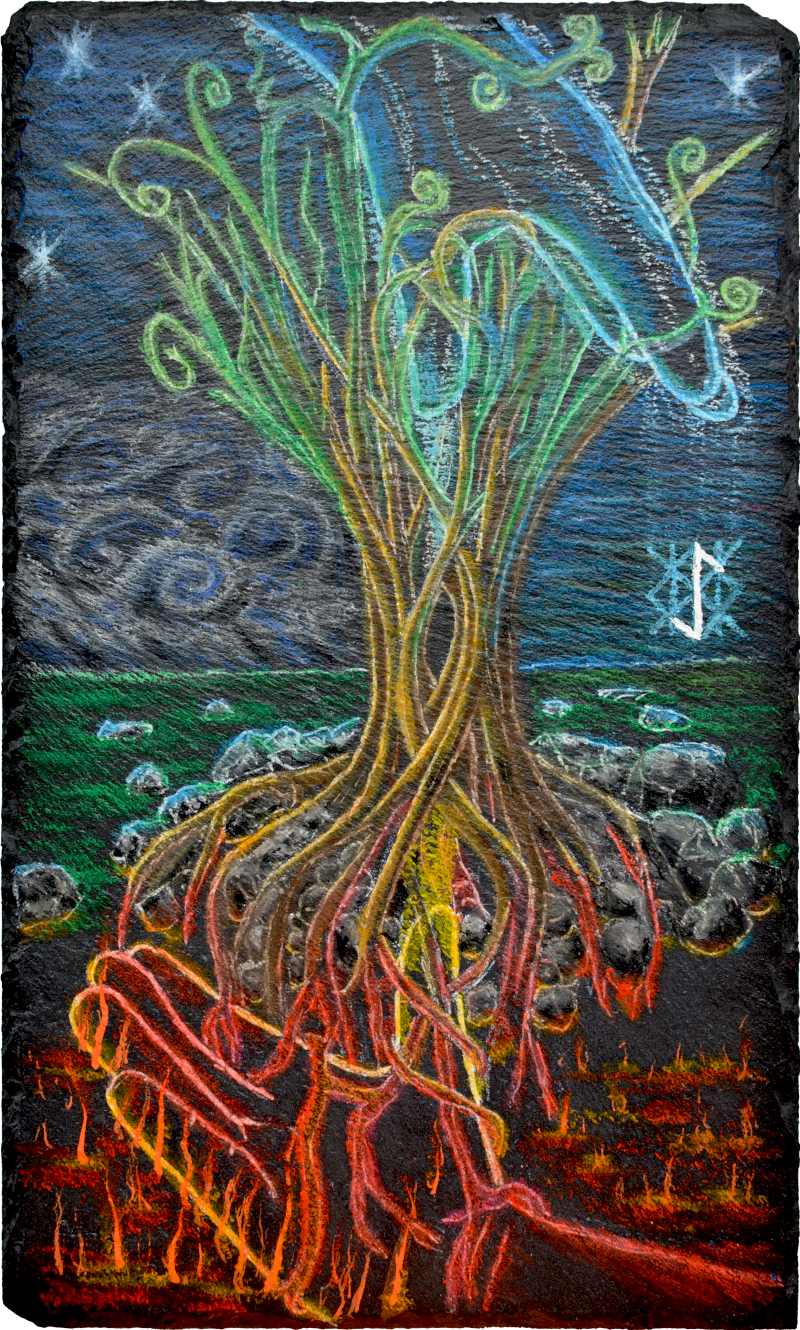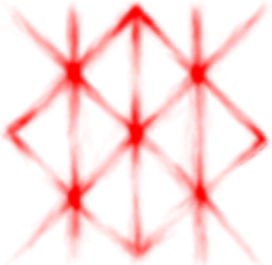13. Eihwaz Rune
The yew is a tree with rough bark, hard and fast in the earth, supported by its roots, a guardian of flame and a joy on native land. -- Anglo-Saxon rune poem.
Despite the "Philosopher's Stone" bind rune being made of two halves, we speak about three phases overlapping each other, and you can see three vertical axes there.
The first, the left one, was Isa.
Let's now find out what is happening in the middle one, and it's a lot.
Once Fire and Water are separated into individual forces, they can interact.
There is now an "egg" of Emptiness in between, where this interaction takes place - Ingwaz.
We have already filled it with Water and Fire, and created a night proto-world with dark, raw Earth, locking the light of Muspelheim down beneath.
We are not left alone in this darkness. With the right direction from Tiwaz and guidance of Raido, we start making sense of this world and our place in it.
Eihwaz means "Yew," and this tree was significant for Norse people from a practical perspective - the best bows were made of it because of its flexibility and resilience. At the same time, yew was rare, especially large and straight enough for bow crafting, so yew wood was expensive and was even a subject of importation. This unique combination of properties and its rarity adds value to the Yew.
From primary sources of Norse Tradition, we know about the direct connection between yews and Ullr, the god of Archery, Hunting, and Skiing. Ullr was also known as a great warrior.
The yew tree lives for thousands of years and remains evergreen, making it a symbol of life. But at the same time yew is toxic and one of the most deadly ranged weapons were made of it. So like a hunting, which takes life from ones and supports in others, yew tree tree can be seen as a tree of life and death.
Due to the rarity of Yew, the second-best wood for crafting bows was Ash. Yggdrasil, the grand tree that connects all the worlds in the universe, is also Ash according to the Eddas. So yet another connection we can establish between Eihwaz and Yggdrasil, which is never stated explicitly in historical sources but is often considered by scholars.
From an alchemical perspective, Eihwaz is an iterative process of recycling and refining raw Earth not yet "processed" by pushing it down to Fire for "remelting" — this is the meaning of the bottom-left descending bar. If we think about a tree as a living organism, it gets resources from "secondary" earth, the soil, left by previous life, and brings it back to the life cycle.
When a portion of raw Earth is pushed down to the Fire, the next part of the rune is a vertical bar of Simultaneity — it works as a rebalancing of all 5 levels. Since the amount of Earth in the egg was reduced, more fresh raw Fire arrives instead.
This brings us to another important layer of Eihwaz - regeneration. Life, to keep itself, constantly burns and rebuilds. So, lower descendant bar is this process of burning past, "a guardian of flame"
And vertical bar of Eihwaz is the backbone of the universe, the law of preservation that keeps everything in a perfect dynamic balance and connects opposites to hold everything in the right places.
The last part of the rune, "a joy on native land", is the top-right descending bar, which adds more Water into the system, which interacts with fresh Fire from the first step, giving new Earth and Air to grow something new instead of what's gone, and the entire alchemical process advances.
Doing the Tree
Feel your hands now.
You see your right hand of Fire supports the world from the bottom and your left hand of Water covers it from the top:

You can now feel why Eihwaz is the rune of protection - you are both parents, Fire and Water.
- Tune into the Earth somewhere on the level of your belly and down. Feel it not only in yourself but also in the world around you.
- Slowly breathe out and along with this exhalation, slide the energy of Earth down deeper to the world of Fire, somewhere below your feet.
This is the bottom-left descending bar of the rune. - During the small pause after that notice, you may feel a little extra pressure in your head. It's because you changed the balance in your system. You reduced Earth, so new, fresh Fire arrived instead.
- Make a gentle, slow inhale and feel your entire vertical axis, which stands across all the levels starting from Fire, through Earth, Emptiness in the middle, Air, and Water on the top. This is a vertical bar of the Eihwaz rune represented by both your thumbs pointing to the center.
- After doing so, you will find yourself on the way to a new balance and that small extra pressure steps down from the head.
- With a second slow, relaxed exhalation, let the Water fall onto your head and flow down through yourself. This last step is the last, top-right descending bar.
Breathing helps to manage attention, and doing Eihwaz step by step helps understand each of its aspects.
But after some practice, we want and can do everything as a single steady holistic process, not dependent on breathing and without causing temporal pressure and energy fluctuations.
We want and can achieve true balance.
Balance both static, as represented by the vertical axis of simultaneity.
And dynamic, as represented by two diagonal bars, compensating continuous changes made by each other.
When you catch this triple state of Eihwaz, notice how the trunk resonates with your vertical axis, so you may start feeling you are holding yourself in your hands. This bigger you, who holds you between palms, probably longer than you think, and watching your life, who is it?
